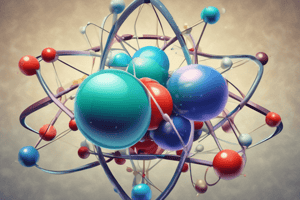Podcast
Questions and Answers
What is the key difference between Thomson's Model and Rutherford's Model of the atom?
What is the key difference between Thomson's Model and Rutherford's Model of the atom?
Thomson's Model depicted atoms as a positive sphere with embedded electrons, while Rutherford's Model introduced the concept of a dense nucleus with electrons orbiting around it.
How do isotopes of the same element differ from each other?
How do isotopes of the same element differ from each other?
Isotopes of the same element have the same number of protons but differ in the number of neutrons.
Define cations and explain how they are formed.
Define cations and explain how they are formed.
Cations are positively charged ions formed when an atom loses one or more electrons.
Describe the Quantum Mechanical Model of the atom.
Describe the Quantum Mechanical Model of the atom.
What role do valence electrons play in chemical bonding?
What role do valence electrons play in chemical bonding?
How does the concept of isotopic abundance affect atomic mass?
How does the concept of isotopic abundance affect atomic mass?
What is the significance of the atomic number?
What is the significance of the atomic number?
Explain how the Bohr Model refined our understanding of atomic structure.
Explain how the Bohr Model refined our understanding of atomic structure.
Flashcards
Atomic Structure
Atomic Structure
Atoms are the basic building blocks of matter, containing a nucleus (protons and neutrons) surrounded by electrons.
Atomic Number
Atomic Number
The number of protons in an atom's nucleus; unique for each element.
Valence Electrons
Valence Electrons
Electrons in the outermost energy level of an atom, crucial for chemical bonding.
Isotopes
Isotopes
Signup and view all the flashcards
Ions
Ions
Signup and view all the flashcards
Atomic Mass
Atomic Mass
Signup and view all the flashcards
Cations
Cations
Signup and view all the flashcards
Quantum Mechanical Model
Quantum Mechanical Model
Signup and view all the flashcards
Study Notes
Atomic Structure
- Atoms are the basic building blocks of matter.
- Atoms consist of a nucleus containing protons and neutrons, surrounded by orbiting electrons.
- The nucleus is extremely small compared to the overall size of the atom.
- Protons have a positive charge, neutrons are neutral, and electrons have a negative charge.
- The number of protons in an atom's nucleus defines the element.
- The atomic number is the number of protons in an atom. It is unique for each element.
- Atomic mass is roughly equivalent to the sum of the number of protons and neutrons in an atom.
- Electrons orbit the nucleus in energy levels or shells.
- The outermost shell is called the valence shell, and the electrons in this shell are called valence electrons. These are important in chemical bonding.
- Electrons within atoms exist in quantized energy levels.
Atomic Models
- Different models have been proposed to understand the structure of the atom over time.
- Dalton's Model: Proposed atoms as indivisible spheres.
- Thomson's Model (Plum Pudding Model): Suggested atoms had a positive sphere with negatively charged electrons embedded within.
- Rutherford's Model: Discovered the nucleus, proposing a dense, positive nucleus with electrons orbiting around it. This model was a major step forward.
- Bohr's Model: Further refined atomic structure by proposing electrons orbit the nucleus in specific energy levels.
- Quantum Mechanical Model: The current model which describes electrons as existing in orbitals within regions of probability rather than fixed orbits, capturing the wave-like properties of electrons.
Isotopes
- Isotopes of an element have the same number of protons but different numbers of neutrons.
- Isotopes have different atomic masses.
- Isotopes of an element have identical chemical properties because the number of electrons and electron configuration is the same.
- The proportion of isotopes in a naturally occurring sample of an element is consistent, useful for dating or measurement in experiments.
- Isotopic abundance affects the atomic mass of each isotope.
Ions
- Ions are atoms that have gained or lost electrons, leading to a net positive or negative charge.
- Atoms gain or lose electrons to achieve a stable electron configuration (usually 8 valence electrons). This is often done through chemical reactions.
- Cations are atoms that have lost one or more electrons, resulting in a positive charge.
- Anions are atoms that have gained one or more electrons, resulting in a negative charge.
- The positive or negative charge of an ion is expressed by a superscript (e.g., Na+, Cl-).
- Ions play critical roles in various chemical and biological processes.
Studying That Suits You
Use AI to generate personalized quizzes and flashcards to suit your learning preferences.




